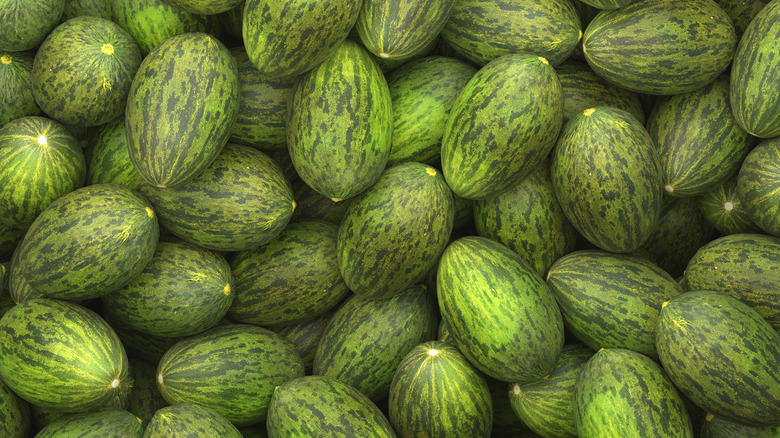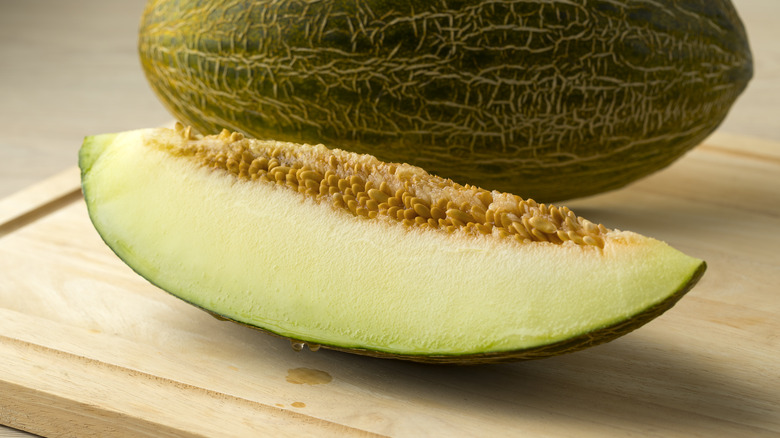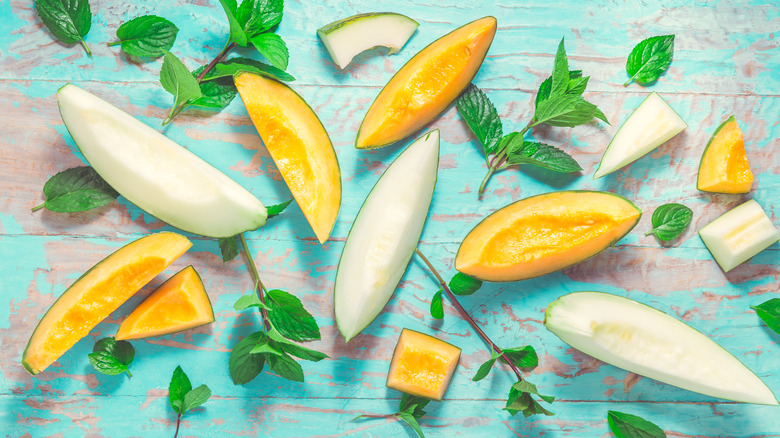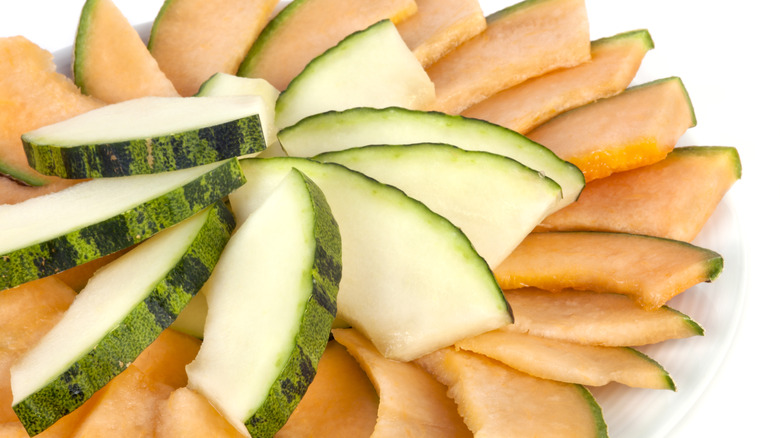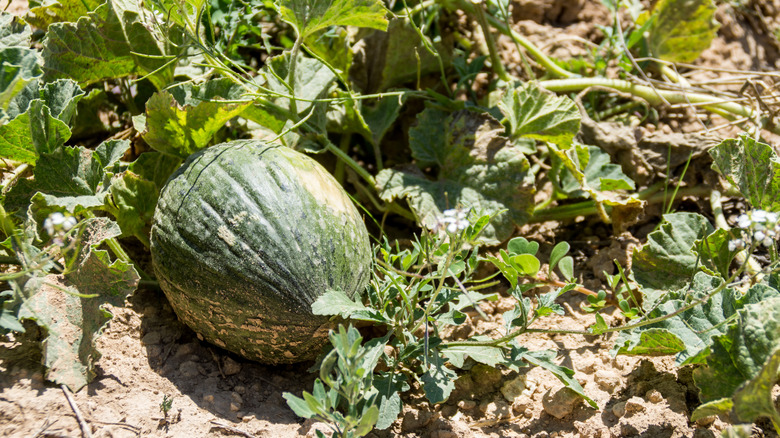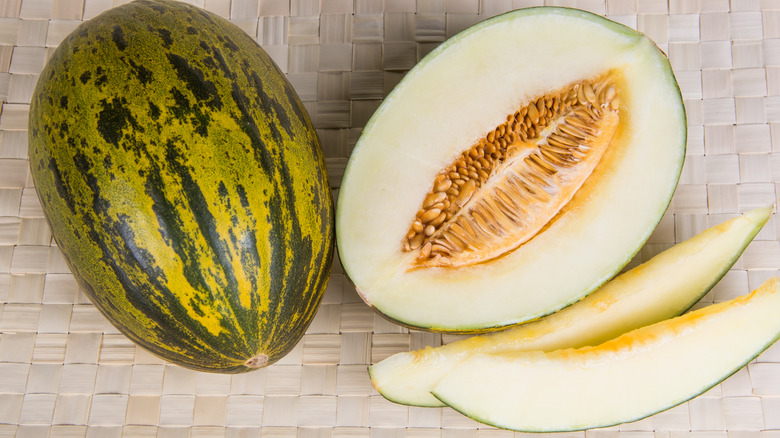What Is A Santa Claus Melon And What Does It Taste Like?
When summer rolls around, there are few foods you start craving more than fresh fruit. While various berries and other in-season fruits often make the cut for your annual barbecue or pool party shopping list, ripe, juicy melons often get overlooked. You may stock up on favorites like watermelon and cantaloupe, but there are a handful of others worth trying out. One of these is a lesser-known melon that has a bit of a misleading name: the Santa Claus melon (Cucumis melo var. inodorus).
This type of fruit is also often referred to as the Christmas melon, which surprisingly hits its peak ripeness during the summer months. It has a balanced flavor that's sweet yet not overly sugary with a hint of earthiness. Including this on your party menu lineup is sure to impress your guests and have them asking for more. However, depending on where in the world you're located, it might be a bit tricky to get your hands on.
What is a Santa Claus melon?
Santa Claus melons have been cultivated for centuries, and they are native to Turkey. Today, they are mostly grown in the Southeast and Central regions of Murcia and La Mancha in Spain. However, many locations with appropriately hot climates grow this fruit, from the Middle East to the Southwestern U.S. to several countries in Latin America.
Similar to a honeydew, these melons have a season that stretches into the fall months. Ripe Santa Claus melons can still be harvested from June well into October, and they stay fresh for around two months afterward, meaning they can be eaten and enjoyed during the Christmas season as well.
Santa Claus melons have a tough and bumpy dark green skin. Their Spanish name, piel de sapo, translates to "toad skin," clearly making note of the fruit's appearance. They are oval shaped and come to a curved point on either end. They also aren't too big, usually growing between 8 to 12 inches. However, they can weigh up to 9 pounds.
When you slice through the thick rind, a light green, almost white, flesh is revealed and it should have a smooth and soft texture that is easy to bite into. The center cavity is full of seeds surrounded by a slimy, stringy texture.
What does Santa Claus melon taste like?
When selecting a whole Santa Claus melon from the store or farmers market, you likely aren't going to be aware olfactory-wise that the fruit is ready to slice into. Rather, you will rely on visual signs that the fruit is ripe. However, once you cut through the durable skin, you will get hit with its light, saccharine scent that makes it incredibly inviting to bite into.
The fruit tastes just like it smells. It's not an overly strong flavor, but it is rather sweet with a slight earthiness that makes it more rounded and mild. It can be compared to the flavor of a honeydew, both less robust in taste but undoubtedly refreshing. It's also frequently compared to lesser-known melons, like the crenshaw and casaba. These characteristics make Santa Claus melon a great addition to fruit salads and other dishes that are frequently enjoyed in the summer.
How to cook Santa Claus melon
A classic watermelon and feta salad is a staple of summer, and throwing in fresh cubes of Santa Claus melon can elevate the meal by adding a smooth textured, more subtle tasting fruit. Santa Claus melons also pair well alongside others, like honeydew or cantaloupe in a mint and melon fruit salad that is mixed with blueberries and fresh sprigs of mint. Aside from fruit salads, these can also be added into smoothies, sliced over a bowl of oatmeal, diced up for summer salsa, or sliced along with your favorite meats and cheese on a charcuterie board.
If you're not a fan of mixing and matching flavors and textures, this fruit can be enjoyed solo. However you prefer to slice up your melons, whether it's biting into wedge slices or popping bite-sized melon balls into your mouth, Santa Claus melon can be prepared in any of the ways you like. However, depending on where you live, it might be a little difficult to get your hands on this warm-climate-loving fruit.
Where to buy Santa Claus melon
If you're traveling around Europe or Latin America, this fruit is more commonly found in local markets or grocery stores. However, these countries do export their melons to North American markets during the winter. While you might get lucky sourcing this fruit in the imported fruit section of your local grocery store, browsing specialty stores near you or markets in the Southwestern U.S. are your best bet. You can also make it easy for yourself by ordering this fruit online via stores like Urban Farmer or Trade Winds Fruit.
When selecting a ripe Santa Claus melon, it's important to note the color of the fruit. If the melon is displaying yellow-colored streaks, this is a sign it is sweet and ready to eat. However, darker colored melons may still need time to reach their peak ripeness. You can also tell by gently pressing the skin or the end of the fruit — if there is a slight give, the melon is perfectly ripe. If it is too firm it can sit on your kitchen counter for a few more days, but if it's overly squishy it's likely past its prime. Another sign that the fruit is ready to eat is by feeling the weight; it should be quite heavy and dense.
Nutritional information about Santa Claus melon
While many melons have a sweet flavor that can often taste similar to candy, these fruits are quite beneficial for you to incorporate into a daily diet. And, Santa Claus melons are no exception.
These fruits are very low in fat and have minimal calories. They are also a great source of essential vitamins and minerals, such as calcium, iron, potassium. Particularly, this melon is rich in vitamin C, which is integral to healthy immune systems, per L'ortodi Eleonora. This melon, along with others, is made up mostly of water, so this means enjoying this fruit on a hot day will help keep you plenty hydrated.
With Santa Claus melons being easy to serve, enjoyable to eat, and great for your overall nutritional intake, this fruit is an ideal match for serving at your picnic tables and incorporating in your summertime platters and fruit bowls.
